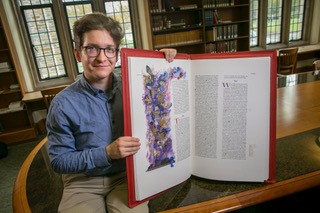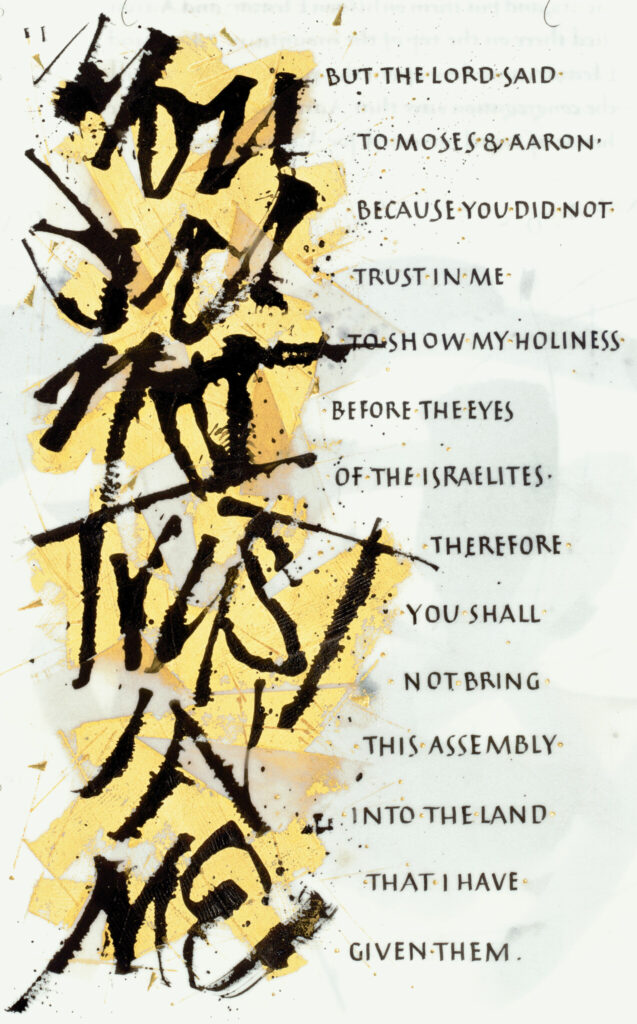
Jonathan Homrighausen, a doctoral candidate in Hebrew Bible at Duke University, has recently released his second book, Planting Letters and Weaving Lines. The book illuminates how the beauty and artistry of the calligraphy in The Saint John’s Bible’s handwritten Scripture elevates the rich ways in which we experience the Bible.
While he was a student assistant in the archives and special collections at Santa Clara University in California, Jonathan became familiar with the school’s seven volumes of The Saint John’s Bible Heritage Edition. When visitors expressed curiosity, Jonathan was eager to share what he had learned. From there, his own fascination with The Saint John’s Bible only grew.
Calligraphy: A Powerful Art Form
While witnessing peoples’ interactions with the handwritten Scripture, Johnathan observed that people would primarily comment on the images. “They’d glance at the lettering and say, ‘Oh, it’s pretty,’ and nothing more. I think that’s because calligraphy is an art form that we haven’t been taught how to look at.”
Jonathan began to study calligraphy. “In talking with the calligraphers, they helped me see The Saint John’s Bible through a new lens that was different than how I’d viewed it before.” He added, “I wanted to share more about the calligraphers, their craft, and their tools which makes the story of the Bible really rich.”
The humanity found in The Saint John’s Bible is in the movement only calligraphy can express. “Somebody was holding this pen, this quill, and that somebody was moving their hand,” he said. “You can see the gestures of someone’s body as they’re moving across the page.” There is power behind the formation of letters and words in the text which allows the Scripture to come alive on the page.
More than Just Words

The illustration of letters by Thomas Ingmire in the Book of Numbers is a good example of the rich experience that calligraphy can create. “The power behind his gestures, the jagged lines, they all convey the feeling of the words, of God’s disappointment, anger, and frustration,” Johnathan noted, pointing out the harsh lettering. “It communicates more through its form, through how it’s written, than just by what the words of the scripture signify.”
Like his first book, Planting Letters and Weaving Lines touches on the conversations between cultures and religions throughout the Bible. In addition to traditional Roman calligraphy, elements of Eastern art and movement can be found in treatments done by Susie Lieper, who lived in Hong Kong and studied Chinese calligraphy. Notably, the Bible features Hebrew lettering by Izzy Pludwinski. “This is an example of the conversation between religions, between Judaism and Christianity,” explained Jonathan.
Viewing the Bible Through New Eyes
With the religious and cultural conversations in both the illuminations and calligraphy Jonathan says it is clear that the creation of The Saint John’s Bible is unlike any other. “It’s put together from the ground up,” he said. “What makes this different is that, when I show the Bible, there’s always a sense of awe, of realization that people did this by hand, and it took a lot of time, people, and resources.”
Jonathan hopes that, with his book Planting Letters and Weaving Lines, others will be inspired to view the Bible and its powerful calligraphy through new eyes.
You can find copies of Jonathan’s book, Planting Letters and Weaving Lines, on the Liturgical Press website.
